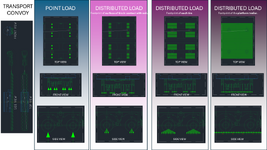It depends what exactly you mean. If you are thinking about a heavy load that needs to go from point A to point B, and how the bridges on that path are evaluated, that is one thing; if you are thinking about how we design a new bridge, and if we consider large/unique trucks, that is another.
When routing a permit load, many state DOT's use software, such as AASHTOWare Bridge Rating, which maintains a database of bridges, each with a structural model of all unique elements (girders and sometimes diaphragms/cross frames) on the bridge. Where a truck is pretty unique, this software can be used to take that specific loading and essentially "run it" over the bridges along the route that a permit load will travel, and get an output of all of the ratings, where a rating is a calculated value where a number greater than 1 indicates the element is adequate and less than 1 is inadequate, and with that information, the engineer (usually in the state bridge office) will decide if the truck can travel along a specific route. The rating includes load resistance factors, and a factor for impact, so in real life, a rating < 1.0 does not mean the bridge will fall down or receive permanent damage, however, taking things to their limit, especially expensive infrastructure, is generally not wise.
One thing to consider, though, is that most permit loads do not need to be run through software. New bridges are rated as part of the design process, and although many existing bridges weren't rated when they were designed, they have since been rated based on as-built plans and/or field observations. When we perform a rating, we rate it for the current (or current at time of construction) design loading, which includes a truck load and a lane load. The truck load represents a heavy and short truck. The lane load represents essentially a line of trucks stopped in traffic. We also rate for a number of "legal loads" and "permit loads", which represent a range of axle arrangements and axles loads. Most trucks, even heavy loads, will look a lot like one of these loads, or can be modified to fall under one of those loading conditions. If a permit truck has a good analogy to an existing rating, then its a simple task to look at all of the bridges impacted, compile the already existing ratings for the truck type, and determine if there are any issues.
In terms of design, we don't necessarily think too much about unusual truck loading. The current US design load, which is called HL-93, includes a lane load of 640 lb/ft plus either a truck load (a 72,000 lb truck that ranges from 28' to 44' long) or a tandem load (two 25000 axles spaced at 4'), generally results in designs that rate very well for most permit loads. These loads are arranged in order to maximize load effects. Many states also include a permit truck load in the design process. These loads are then increased by a factor of 1.75, and typically, an impact load of 1.33 is also applied to the truck portion of the load. These design loads are intentionally conservative, and typically result in bridges that will not see damage due to overloading over their lives, even on routes where permit loads are a regular occurance.
Also keep in mind that, although permit loads can be heavy, the trucks are often modular, so axles can be added as needed in order to spread out the load. In these cases, a long length is actually helpful, because there is more room to spread out the load.


